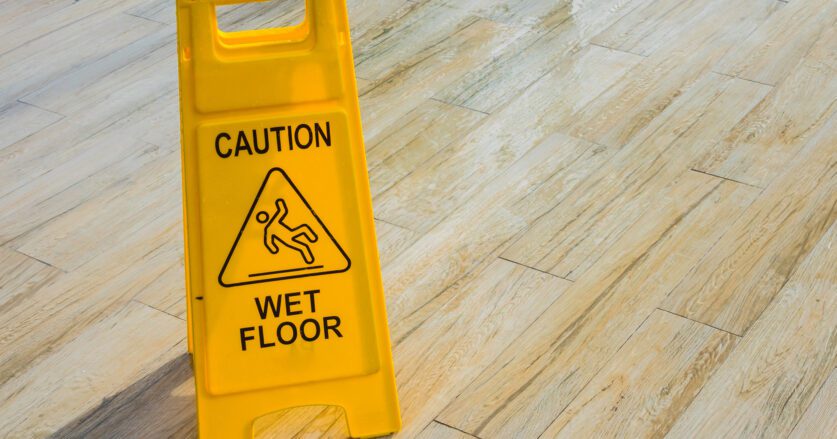26 Jul
Ergonomic Tip of the Month
Preventing Slips, Trips and Falls – A Problem Gaining Importance in an Aging Workforce.
Accidents involving slips, trips and falls send 9 million people to the hospital each year and are a leading cause of workers’ compensation claims, costing an average of $20,000 per accident. It’s the number one reason for claims for workers age 65 and older. Remember, as people age reaction times to loss of balance and avoiding a fall are reduced, depth perception becomes altered increasing the risk of trips and falls, and ability to see in dim light is compromised.
About 95 million workdays per year are lost due to slip-and-fall injuries. Wet walking surfaces is the cause for slips and falls 55 percent of the time. In fact, according to reports, 50 percent of facility accidents can actually be attributed to the type of flooring used. Regardless of cause, these accidents can cost facilities big bucks in unemployment and liability claims.
According to the U.S. Department of Labor’s Occupational Safety & Health Administration (OSHA), slips, trips and falls account for 15 percent of all accidental deaths, and are second only to motor vehicles as a cause of fatalities.
“Last year there were 822 occupational deaths due to falls,” says Don Ostrander, CSP, director of consulting services occupational safety and health at the National Safety Council in Itasca, Ill. “The large majority of those were due to falls from one level to another.”
According to the 2006 Liberty Mutual Workplace Safety Index, the annual direct cost of disabling occupational injuries due to slips, trips and falls is estimated to exceed $11 billion. The Index reports that falls on the same level are the second most costly occupational injury (estimated annual cost of $6.7 billion), just behind overexertion. It also shows that bodily reaction, which comprises injuries from slipping or tripping, is the third highest injury category, followed by falls to a lower level (4.6 billion).
The average cost from slip and falls is $22,800 per accident. The average workers compensation claim is $19,000. These numbers often account for medical costs alone, a hefty fine for an accident that could have been prevented. If an employee has an accident, managers must also factor in potential replacement workers, the salary of the unemployed staff member, restricted duty for that person, etc.
Here are five suggestions from Grainger to help create a safer environment at work and at home:
- Create good housekeeping practices
– Proper housekeeping is a routine. Some simple steps can help create an effective housekeeping program. Plan ahead, and know what needs to be done, who is going to do it and how the work area should look when the work is completed. Assign responsibilities; while it is preferable for individuals to clean up after themselves, it may be necessary to assign a specific person or group to clean up. Move items in cabinets so that things used most often are on lower shelves, about waist level. Always keep objects off the floor. Pick up papers, books, shoes, boxes or other things that are on the floor.
- Reduce wet or slippery surfaces
– Accidents on walking surfaces account for a significant portion of injuries reported by state agencies. Most often injuries occur on parking lots, sidewalks, food preparation areas and showers. Keep parking lots and sidewalks free of debris and in good repair. Use adhesive striping material or anti-skid paint outdoors and anti-skid adhesive tape indoors. Use moisture-absorbent mats with beveled edges in entrance areas. Make sure they have backing material that will not slide on the floor. Use proper area rugs or mats for food preparation areas. Place a nonslip rubber mat or self-stick strips on the floor of showers and tubs. Install grab bars inside the tub.
- Avoid creating obstacles in aisles and walkways
– Obstacles, clutter, materials and equipment in aisles, corridors, entranceways and stairwells also contribute to trips injuries. Keep all work areas, passageways, storerooms and service areas clean and orderly. Close file cabinets and drawers after use. Coil or tape wires such as cables, air hoses, extension cords, lamp and phone cords next to the wall. Do not string materials across hallways or designated aisles. Always keep objects off stairs. Fix loose, broken or uneven steps and make sure that the carpet is firmly attached to every step.
- Create and maintain proper lighting
– Poor lighting in the workplace or at home can contribute to causing an increase in accidents. Use proper illumination in staircases, ramps, hallways, basements, construction areas and dock areas; keep poorly lit walkways clear of clutter and obstructions. Keep work areas well lit and clean. Keep areas around light switches clear and accessible. Repair fixtures, switches and cords immediately if they malfunction. At home, place a lamp close to the bed where it is easy to reach. Older people require much more light to see with good acuity.
- Wear proper shoes
– Proper shoes play a big part in preventing falls. Pay attention to the slickness of the soles and the type of heels; tie shoelaces correctly. At work, educate employees on the appropriate footwear for their duties.


![]()